Targeted Metabolomic Analysis Reveals Solvent-Dependent Phenolic Variation and Associated Antioxidant and Antibacterial Activity in Coriander Seeds (Coriandrum sativum L.)
Abstract
1. Introduction
2. Results and Discussion
2.1. Total Phenolic Content (TPC) and Antioxidant Capacity of Coriander Seeds
2.2. Extraction Yield of Different Extracts of Coriander Seeds
2.3. In Vitro Antibacterial Activity of Coriander Seed Extracts
2.3.1. Inhibition Zone Diameter of Different Coriander Seed Extracts
2.3.2. Determination of Minimum Inhibitory Concentration (MIC), Minimum Bactericidal Concentration (MBC), and MBC/MIC Ratio
2.4. The Total Phenolic Content (TPC) and Antioxidant Capacity of Active Extracts of Coriander Seeds
2.5. Identification and Quantification of Phenolic Compounds in Coriander Seed Extracts
2.6. Correlation Analysis
3. Materials and Methods
3.1. Chemicals and Reagents
3.2. Sample Collection and Preparation
3.3. Extraction of Phenolic Compounds and Antioxidants
3.4. Total Phenolic Content (TPC) of Coriander Seeds
3.5. Antioxidant Capacity of Coriander Seeds
3.5.1. Cupric-Reducing Antioxidant Capacity (CUPRAC)
3.5.2. Ferric-Reducing Antioxidant Power (FRAP)
3.6. Preparation of Coriander Seed Extracts for Antibacterial Assay
3.6.1. Preparation of Polar Extracts (Water, Methanol, and Ethanol) of Coriander Seeds
3.6.2. Preparation of Semi-Polar and Non-Polar Extracts (Acetone, Ethyl Acetate, and Hexane) of Coriander Seeds
3.7. In Vitro Antibacterial Activity of Coriander Seeds
3.7.1. Preparation of Agar Plates
3.7.2. Culture and Maintenance of Test Bacteria
3.7.3. Sample Preparation for Antibacterial Activity
3.7.4. Agar-Well Diffusion Method
3.7.5. Minimum Inhibitory Concentration (MIC)
3.7.6. Minimum Bactericidal Concentration (MBC)
3.8. Total Phenolic Content and Antioxidant Capacity of Active Seed Extracts
3.9. LC-MS/MS Analysis of Phenolic Compounds
4. Statistical Analysis
5. Conclusions
Supplementary Materials
Author Contributions
Funding
Data Availability Statement
Acknowledgments
Conflicts of Interest
References
- Laribi, B.; Kouki, K.; M’Hamdi, M.; Bettaieb, T. Coriander (Coriandrum sativum L.) and its bioactive constituents. Fitoterapia 2015, 103, 9–26. [Google Scholar] [CrossRef]
- Mechchate, H.; Es-Safi, I.; Amaghnouje, A.; Boukhira, S.; Alotaibi, A.; Al-Zharani, M.; Nasr, F.A.; Noman, O.M.; Conte, R.; Amal, E.H.E.Y.; et al. Antioxidant, Anti-Inflammatory and Antidiabetic Proprieties of LC-MS/MS Identified Polyphenols from Coriander Seeds. Molecules 2021, 26, 487. [Google Scholar] [CrossRef]
- Kodikara, B.; Undugoda, L.; Karunaratne, H.; Kandisa, R. Antibacterial and Antiviral Properties of Coriandrum Sativum and Zingiber Officinale against Human Respiratory Tract Related Bacterial and Viral Infections: A Review with a Focus on the Case of SARS-CoV. Adv. Technol. Innov. 2022, 2, 361–381. [Google Scholar] [CrossRef]
- Scandar, S.; Zadra, C.; Marcotullio, M.C. Coriander (Coriandrum sativum) Polyphenols and Their Nutraceutical Value against Obesity and Metabolic Syndrome. Molecules 2023, 28, 4187. [Google Scholar] [CrossRef]
- Gastón, M.S.; Cid, M.P.; Vázquez, A.M.; Decarlini, M.F.; Demmel, G.I.; Rossi, L.I.; Aimar, M.L.; Salvatierra, N.A. Sedative Effect of Central Administration of Coriandrum sativum Essential Oil and Its Major Component Linalool in Neonatal Chicks. Pharm. Biol. 2016, 54, 1954–1961. [Google Scholar] [CrossRef]
- Sumalan, R.M.; Alexa, E.; Popescu, I.; Negrea, M.; Radulov, I.; Obistioiu, D.; Cocan, I. Exploring Ecological Alternatives for Crop Protection Using Coriandrum sativum Essential Oil. Molecules 2019, 24, 2040. [Google Scholar] [CrossRef]
- Kačániová, M.; Galovičová, L.; Ivanišová, E.; Vukovic, N.L.; Štefániková, J.; Valková, V.; Borotová, P.; Žiarovská, J.; Terentjeva, M.; Felšöciová, S.; et al. Antioxidant, Antimicrobial and Antibiofilm Activity of Coriander (Coriandrum sativum L.) Essential Oil for Its Application in Foods. Foods 2020, 9, 282. [Google Scholar] [CrossRef]
- Parsaeyan, N. The Effect of Coriander Seed Powder Consumption on Atherosclerotic and Cardioprotective Indices of Type 2 Diabetic Patients. Iran. J. Diabetes Obes. 2012, 4, 86–90. [Google Scholar]
- Bag, A.; Chattopadhyay, R.R. Evaluation of Synergistic Antibacterial and Antioxidant Efficacy of Essential Oils of Spices and Herbs in Combination. PLoS ONE 2015, 10, e0131321. [Google Scholar] [CrossRef] [PubMed]
- Alves, S.; Duarte, A.; Sousa, S.; Domingues, F.C. Study of the major essential oil compounds of Coriandrum sativum against Acinetobacter baumannii and the effect of linalool on adhesion, biofilms and quorum sensing. Biofouling 2016, 32, 155–165. [Google Scholar] [CrossRef] [PubMed]
- Eid, A.M.; Issa, L.; Al-Kharouf, O.; Jaber, R.; Hreash, F. Development of Coriandrum sativum Oil Nanoemulgel and Evaluation of Its Antimicrobial and Anticancer Activity. Biomed. Res. Int. 2021, 2021, 5247816. [Google Scholar] [CrossRef]
- Khan, D.; Hassan, F.; Ullah, H.; Karim, S.; Baseer, A.; Ali, M.; Ubaidi, M.; Khan, S.; Murtaza, G. Antibacterial activity of Phyllantus emblica, Coriandrum sativum, Culinaris medic, Lawsonia alba and Cucumis sativus. Acta Pol. Pharm. 2013, 70, 855–859. [Google Scholar] [PubMed]
- Salma, S.; Ramakrishnan, L.; Vinothini, J. Screening of antibacterial activity of five different spices (Ajwain, coriander, cumin, fennel, and fenugreek) against pathogenic bacterial strains. Asian J. Pharm. Clin. Res. 2018, 11, 252–254. [Google Scholar] [CrossRef]
- Sasidharan, S.; Chen, Y.; Saravanan, D.; Sundram, K.M.; Yoga Latha, L. Extraction, isolation and characterization of bioactive compounds from plants’ extracts. Afr. J. Tradit. Complement. Altern. Med. 2011, 8, 1–10. [Google Scholar] [CrossRef]
- Tibebe, D.; Belete, A.; Kassa, Y.; Mulugeta, M.; Moges, Z.; Yenealem, D.; Fentie, T.; Amare, A. Evaluation of Total Phenolic, Flavonoid Contents, and Antioxidant Activities of Seed Extracted from Coriander (Coriandrum sativum L.) and Black Cumin (Nigella sativa) Spices. Food Anal. Methods 2024, 17, 945–955. [Google Scholar] [CrossRef]
- Hameed, S.; Imran, A.; Nisa, M.u.; Arshad, M.S.; Saeed, F.; Arshad, M.U.; Asif Khan, M. Characterization of extracted phenolics from black cumin (Nigella sativa linn), coriander seed (Coriandrum sativum L.), and fenugreek seed (Trigonella foenum-graecum). Int. J. Food Prop. 2019, 22, 714–726. [Google Scholar] [CrossRef]
- Msaada, K.; Jemia, M.B.; Salem, N.; Bachrouch, O.; Sriti, J.; Tammar, S.; Bettaieb, I.; Jabri, I.; Kefi, S.; Limam, F.; et al. Antioxidant activity of methanolic extracts from three coriander (Coriandrum sativum L.) fruit varieties. Arab. J. Chem. 2017, 10, S3176–S3183. [Google Scholar] [CrossRef]
- Ianni, F.; Scandar, S.; Mangiapelo, L.; Blasi, F.; Marcotullio, M.C.; Cossignani, L. NADES-Assisted Extraction of Polyphenols from Coriander Seeds: A Systematic Optimization Study. Antioxidants 2023, 12, 2048. [Google Scholar] [CrossRef]
- Bhat, S.; Kaushal, P.; Kaur, M.; Sharma, H. Coriander (Coriandrum sativum L.): Processing, nutritional and functional aspects. Afr. J. Plant Sci. 2014, 8, 25–33. [Google Scholar] [CrossRef]
- Demir, S.; Korukluoglu, M. A comparative study about antioxidant activity and phenolic composition of cumin (Cuminum cyminum L.) and coriander (Coriandrum sativum L.). Indian J. Tradit. Knowl. 2020, 19, 383–393. [Google Scholar] [CrossRef]
- Xia, P.; Ahmmed, M.K.; Rashidinejad, A. Exploring efficient extraction methods: Bioactive compounds and antioxidant properties from New Zealand damson plums. Food Biosci. 2023, 55, 103057. [Google Scholar] [CrossRef]
- Saxena, S.N.; Sharma, Y.K.; Rathore, S.S.; Singh, K.K.; Barnwal, P.; Saxena, R.; Upadhyaya, P.; Anwer, M.M. Effect of cryogenic grinding on volatile oil, oleoresin content and anti-oxidant properties of coriander (Coriandrum sativum L.) genotypes. J. Food Sci. Technol. 2015, 52, 568–573. [Google Scholar] [CrossRef]
- Balbino, S.; Repajić, M.; Obranović, M.; Medved, A.M.; Tonković, P.; Dragović-Uzelac, V. Characterization of lipid fraction of Apiaceae family seed spices: Impact of species and extraction method. J. Appl. Res. Med. Aromat. Plants 2021, 25, 100326. [Google Scholar] [CrossRef]
- Shahwar, M.K.; El-Ghorab, A.H.; Anjum, F.M.; Butt, M.S.; Hussain, S.; Nadeem, M. Characterization of Coriander (Coriandrum sativum L.) Seeds and Leaves: Volatile and Non Volatile Extracts. Int. J. Food Prop. 2012, 15, 736–747. [Google Scholar] [CrossRef]
- Palmieri, S.; Pellegrini, M.; Ricci, A.; Compagnone, D.; Lo Sterzo, C. Chemical Composition and Antioxidant Activity of Thyme, Hemp and Coriander Extracts: A Comparison Study of Maceration, Soxhlet, UAE and RSLDE Techniques. Foods 2020, 9, 1221. [Google Scholar] [CrossRef]
- Susanti, D.A.; Hidayati, S.; Milunier, F.M.P. Antibacterial Potential of Ethanol Extract of Coriander Seeds (Coriander sativum) Against Staphylococcus aureus. Blambangan J. Nurs. Health Sci. 2023, 1, 1–6. [Google Scholar] [CrossRef]
- Zeynel, A.A.; Abbas, U. In-vitro study of antibacterial properties and phytochemical contents of coriander seeds against five bacteria. Kirkuk Univ. J. Sci. Stud. 2019, 14, 1–18. [Google Scholar] [CrossRef]
- Chaudhary, A.A.; Chauhan, V.; Ansari, S.; Khan, M. In vitro antimicrobial potential of Coriandrum sativum against pathogenic microorganisms. Int. J. Adv. Res. 2014, 2, 208–211. [Google Scholar]
- Andrews, J.M. Determination of minimum inhibitory concentrations. J. Antimicrob. Chemother. 2001, 48 (Suppl. 1), 5–16. [Google Scholar] [CrossRef] [PubMed]
- Ghazanfari, N.; Mortazavi, S.A.; Yazdi, F.T.; Mohammadi, M. Microwave-assisted hydrodistillation extraction of essential oil from coriander seeds and evaluation of their composition, antioxidant and antimicrobial activity. Heliyon 2020, 6, e04893. [Google Scholar] [CrossRef]
- Kowalczyk, P.; Koszelewski, D.; Brodzka, A.; Kramkowski, K.; Ostaszewski, R. Evaluation of Antibacterial Activity against Nosocomial Pathogens of an Enzymatically Derived α-Aminophosphonates Possessing Coumarin Scaffold. Int. J. Mol. Sci. 2023, 24, 14886. [Google Scholar] [CrossRef]
- Loree, J.; Lappin, S.L. Bacteriostatic Antibiotics. In StatPearls; StatPearls Publishing: St. Petersburg, FL, USA, 2025. [Google Scholar]
- Ozyürek, M.; Bektaşoğlu, B.; Güçlü, K.; Güngör, N.; Apak, R. Simultaneous total antioxidant capacity assay of lipophilic and hydrophilic antioxidants in the same acetone-water solution containing 2% methyl-beta-cyclodextrin using the cupric reducing antioxidant capacity (CUPRAC) method. Anal. Chim. Acta 2008, 630, 28–39. [Google Scholar] [CrossRef]
- Al-Dhabi, N.A.; Arasu, M.V.; Park, C.H.; Park, S.U. An up-to-date review of rutin and its biological and pharmacological activities. Excli J. 2015, 14, 59–63. [Google Scholar] [CrossRef]
- Song, E.-J.; Ko, M.-J. Extraction of monoterpenes from coriander (Coriandrum sativum L.) seeds using subcritical water extraction (SWE) technique. J. Supercrit. Fluids 2022, 188, 105668. [Google Scholar] [CrossRef]
- Dobrinas, S.; Soceanu, A.; Popescu, V.; Carazeanu Popovici, I.; Jitariu, D. Relationship between Total Phenolic Content, Antioxidant Capacity, Fe and Cu Content from Tea Plant Samples at Different Brewing Times. Processes 2021, 9, 1311. [Google Scholar] [CrossRef]
- Mazumder, M.A.R.; Tolaema, A.; Chaikhemarat, P.; Rawdkuen, S. Antioxidant and Anti-Cytotoxicity Effect of Phenolic Extracts from Psidium guajava Linn. Leaves by Novel Assisted Extraction Techniques. Foods 2023, 12, 2336. [Google Scholar] [CrossRef]
- Venkatesan, T.; Choi, Y.-W.; Kim, Y.-K. Impact of Different Extraction Solvents on Phenolic Content and Antioxidant Potential of Pinus densiflora Bark Extract. BioMed Res. Int. 2019, 2019, 3520675. [Google Scholar] [CrossRef]
- Muflihah, Y.M.; Gollavelli, G.; Ling, Y.C. Correlation Study of Antioxidant Activity with Phenolic and Flavonoid Compounds in 12 Indonesian Indigenous Herbs. Antioxidants 2021, 10, 1530. [Google Scholar] [CrossRef] [PubMed]
- Fioroni, N.; Mouquet-Rivier, C.; Meudec, E.; Cheynier, V.; Boudard, F.; Hemery, Y.; Laurent-Babot, C. Antioxidant Capacity of Polar and Non-Polar Extracts of Four African Green Leafy Vegetables and Correlation with Polyphenol and Carotenoid Contents. Antioxidants 2023, 12, 1726. [Google Scholar] [CrossRef] [PubMed]
- Johnson, J.; Collins, T.; Walsh, K.; Naiker, M. Solvent extractions and spectrophotometric protocols for measuring the total anthocyanin, phenols and antioxidant content in plums. Chem. Pap. 2020, 74, 4481–4492. [Google Scholar] [CrossRef]
- Johnson, J.; Collins, T.; Power, A.; Chandra, S.; Skylas, D.; Portman, D.; Panozzo, J.; Blanchard, C.; Naiker, M. Antioxidative properties and macrochemical composition of five commercial mungbean varieties in Australia. Legume Sci. 2020, 2, e27. [Google Scholar] [CrossRef]
- Apak, R.; Gorinstein, S.; Böhm, V.; Schaich, K.M.; Özyürek, M.; Güçlü, K. Methods of measurement and evaluation of natural antioxidant capacity/activity (IUPAC Technical Report). Pure Appl. Chem. 2013, 85, 957–998. [Google Scholar] [CrossRef]
- Johnson, J.B.; Mani, J.S.; Skylas, D.; Walsh, K.B.; Bhattarai, S.P.; Naiker, M. Phenolic profiles and nutritional quality of four new mungbean lines grown in northern Australia. Legume Sci. 2021, 3, e70. [Google Scholar] [CrossRef]
- Manandhar, S.; Luitel, S.; Dahal, R.K. In Vitro Antimicrobial Activity of Some Medicinal Plants against Human Pathogenic Bacteria. J. Trop. Med. 2019, 2019, 1895340. [Google Scholar] [CrossRef]
- Van, N.T.B.; Vi, O.T.; Yen, N.T.P.; Nhung, N.T.; Cuong, N.V.; Kiet, B.T.; Hoang, N.V.; Hien, V.B.; Thwaites, G.; Campell, J.; et al. Minimum inhibitory concentrations of commercial essential oils against common chicken pathogenic bacteria and their relationship with antibiotic resistance. J. Appl. Microbiol. 2022, 132, 1025–1035. [Google Scholar] [CrossRef]
- Gupta, A.; Bernacchia, L.; Kad, N.M. Culture media, DMSO and efflux affect the antibacterial activity of cisplatin and oxaliplatin. Lett. Appl. Microbiol. 2022, 75, 951–956. [Google Scholar] [CrossRef]
- Mogana, R.; Adhikari, A.; Tzar, M.N.; Ramliza, R.; Wiart, C. Antibacterial activities of the extracts, fractions and isolated compounds from Canarium patentinervium Miq. against bacterial clinical isolates. BMC Complement. Med. Ther. 2020, 20, 55. [Google Scholar] [CrossRef]


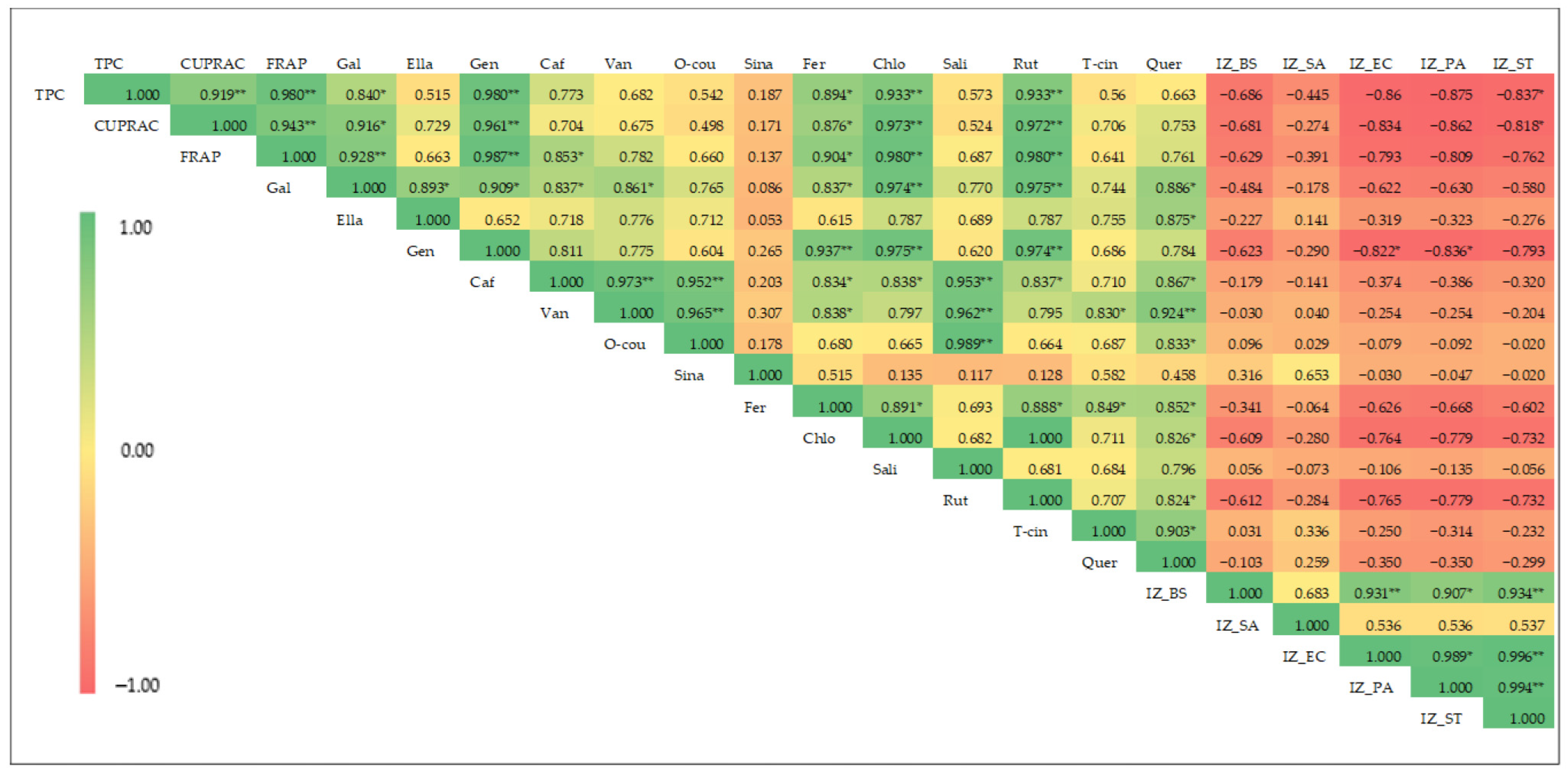
| Commercial Coriander Sample | TPC mg GAE/100 g DW | FRAP mg TRX/100 g DW | CUPRAC mg TRX/100 g DW |
|---|---|---|---|
| In | 274 ± 3 | 424 ± 13 | 1142 ± 13 |
| Hy | 161 ± 3 | 279 ± 10 | 620 ± 20 |
| Coriander Seed Extract | Extraction Yield % (w/w) DW |
|---|---|
| W | 9.3 |
| M1 | 7.1 |
| M2 | 2.2 |
| Et | 12.1 |
| Ace | 7.2 |
| EA | 9.5 |
| He | 12.0 |
| Test Bacteria | Minimum Inhibitory Concentration (MIC) | ||||||
|---|---|---|---|---|---|---|---|
| M1 (% w/v) | M2 (% w/v) | Et (% w/v) | Ace (% w/v) | EA (% w/v) | He (% w/v) | Gen (% w/v) | |
| BS | 2 | 1 | 4 | 1 | 2 | 4 | 1.25 × 10−5 |
| SA | 4 | 2 | 4 | 2 | 2 | 8 | 2.5 × 10−5 |
| EC | - | 8 | - | 4 | 8 | 8 | 10 × 10−5 |
| PA | - | >8 | - | 8 | >8 | >8 | 5 × 10−5 |
| ST | - | 8 | - | 8 | >8 | - | 2.5 × 10−5 |
| Minimum Bactericidal Concentration (MBC) | |||||||
| M1 (% w/v) | M2 (% w/v) | Et (% w/v) | Ace (% w/v) | EA (% w/v) | He (% w/v) | ||
| BS | 4 | 2 | 4 | 2 | 2 | 4 | 1.25 × 10−5 |
| SA | 8 | 8 | 8 | 2 | 4 | 8 | 5 × 10−5 |
| EC | - | 8 | - | 8 | 8 | 8 | 10 × 10−5 |
| PA | - | >8 | - | 8 | >8 | >8 | 20 × 10−5 |
| ST | - | >8 | - | 8 | >8 | - | 5 × 10−5 |
| MBC/MIC ratio | |||||||
| M1 | M2 | Et | Ace | EA | He | ||
| BS | 2 | 2 | 1 | 2 | 1 | 1 | 1 |
| SA | 2 | 4 | 2 | 1 | 2 | 1 | 2 |
| EC | - | 1 | - | 2 | nd | 1 | 1 |
| PA | - | nd | - | 1 | nd | nd | 4 |
| ST | - | nd | - | 1 | nd | nd | 2 |
| Number | Phenolic Compound | Compound Category | Retention Time |
|---|---|---|---|
| 1 | Gallic acid 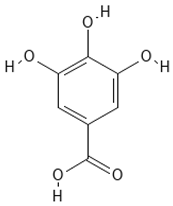 | Hydroxybenzoic acid | 2.48 min |
| 2 | Ellagic acid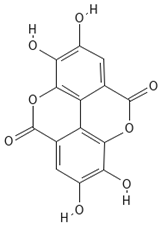 | Hydroxybenzoic acid | 4.62 min |
| 3 | Gentisic acid  | Hydroxybenzoic acid | 5.18 min |
| 4 | Caffeic acid  | Hydroxycinnamic acid | 5.5 min |
| 5 | Vanillic acid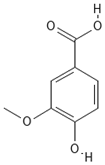 | Hydroxybenzoic acid | 5.51 min |
| 6 | O-coumaric acid | Hydroxycinnamic acid | 6.26 min |
| 7 | Sinapinic acid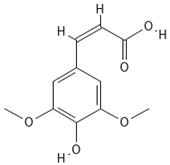 | Hydroxycinnamic acid | 6.28 min |
| 8 | Ferulic acid  | Hydroxycinnamic acid | 6.41 min |
| 9 | Chlorogenic acid 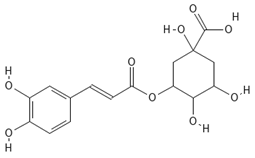 | Hydroxycinnamic acid | 7.00 min |
| 10 | Salicylic acid | Hydroxybenzoic acid | 8.23 min |
| 11 | Rutin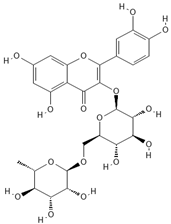 | Flavonoid | 8.28 min |
| 12 | Trans-cinnamic acid  | Cinnamic acid | 9.24 min |
| 13 | Quercetin | Flavonoid | 10.73 min |
| Compound | M1 | M2 | Et | EA | Ace | He |
|---|---|---|---|---|---|---|
| Gallic acid | 13.32 ± 1.07 b | 23.32 ± 1.11 a | 22.99 ± 2.39 a | n.d. | n.d. | n.d. |
| Ellagic acid | n.d. | 53.24 ± 1.01 a | 52.06 ± 1.37 a | n.d. | n.d. | n.d. |
| Gentisic acid | 63.32 ± 4.39 a | 49.87 ± 0.30 b | 68.00 ± 1.66 a | n.d. | 10.44 ± 0.16 c | n.d. |
| Caffeic acid | 523.02 ± 7.11 b | 856.62 ± 6.19 a | 441.72 ± 2.70 c | 38.71 ± 4.96 e | 230.90 ± 2.70 d | 6.15 ± 0.31 f |
| Vanillic acid | 444.11 ± 6.13 c | 825.61 ± 9.53 a | 505.44 ± 8.60 b | 141.13 ± 0.53 e | 345.87 ± 5.71 d | 4.51 ± 0.62 f |
| o-Coumaric acid | 211.03 ± 2.45 b | 526.01 ± 2.18 a | 191.87 ± 1.86 c | 44.12 ± 0.05 e | 171.38 ± 2.44 d | 1.26 ± 0.18 f |
| Ferulic acid | 429.54 ± 1.51 b | 384.90 ± 9.63 c | 457.79 ± 3.56 a | 114.24 ± 1.19 e | 259.95 ± 2.90 d | 3.34 ± 0.14 f |
| Sinapinic acid | 113.30 ± 3.25 b | 62.69 ± 0.50 c | 153.56 ± 3.65 a | 16.43 ± 0.68 e | 37.98 ± 0.79 d | n.d. |
| Chlorogenic acid | 3131.93 ± 40.03 c | 3468.31 ± 42.32 b | 4213.28 ± 27.33 a | 119.59 ± 1.59 d | 73.80 ± 1.13 e | n.d. |
| Salicylic acid | 15.36 ± 0.79 b | 30.83 ± 0.47 a | 12.76 ± 0.13 c | 7.38 ± 0.11 e | 10.50 ± 0.09 d | 1.59 ± 0.19 f |
| Rutin | 7827.25 ± 170.51 c | 8697.93 ± 31.87 b | 10,531.44 ± 213.47 a | 257.08 ± 0.79 d | 77.91 ± 4.79 e | 5.23 ± 0.66 f |
| Trans-cinnamic acid | 15.43 ± 0.68 b | 25.95 ± 4.29 a | 29.77 ± 8.11 a | 12.76 ± 4.66 b | 20.88 ± 4.63 a | n.d. |
| Quercetin | 194.43 ± 20.30 b | 451.06 ± 17.52 a | 423.82 ± 49.00 a | n.d. | 227.33 ± 21.02 b | n.d. |
Disclaimer/Publisher’s Note: The statements, opinions and data contained in all publications are solely those of the individual author(s) and contributor(s) and not of MDPI and/or the editor(s). MDPI and/or the editor(s) disclaim responsibility for any injury to people or property resulting from any ideas, methods, instructions or products referred to in the content. |
© 2025 by the authors. Licensee MDPI, Basel, Switzerland. This article is an open access article distributed under the terms and conditions of the Creative Commons Attribution (CC BY) license (https://creativecommons.org/licenses/by/4.0/).
Share and Cite
Ekanayake, C.P.; Johnson, J.; Batley, R.J.; du Preez, R.; Trotter, T.; Nastasi, J.R.; Strappe, P.; Broszczak, D.; Naiker, M. Targeted Metabolomic Analysis Reveals Solvent-Dependent Phenolic Variation and Associated Antioxidant and Antibacterial Activity in Coriander Seeds (Coriandrum sativum L.). Molecules 2025, 30, 4387. https://doi.org/10.3390/molecules30224387
Ekanayake CP, Johnson J, Batley RJ, du Preez R, Trotter T, Nastasi JR, Strappe P, Broszczak D, Naiker M. Targeted Metabolomic Analysis Reveals Solvent-Dependent Phenolic Variation and Associated Antioxidant and Antibacterial Activity in Coriander Seeds (Coriandrum sativum L.). Molecules. 2025; 30(22):4387. https://doi.org/10.3390/molecules30224387
Chicago/Turabian StyleEkanayake, Charitha P., Joel Johnson, Ryan J. Batley, Ryan du Preez, Tieneke Trotter, Joseph Robert Nastasi, Padraig Strappe, Daniel Broszczak, and Mani Naiker. 2025. "Targeted Metabolomic Analysis Reveals Solvent-Dependent Phenolic Variation and Associated Antioxidant and Antibacterial Activity in Coriander Seeds (Coriandrum sativum L.)" Molecules 30, no. 22: 4387. https://doi.org/10.3390/molecules30224387
APA StyleEkanayake, C. P., Johnson, J., Batley, R. J., du Preez, R., Trotter, T., Nastasi, J. R., Strappe, P., Broszczak, D., & Naiker, M. (2025). Targeted Metabolomic Analysis Reveals Solvent-Dependent Phenolic Variation and Associated Antioxidant and Antibacterial Activity in Coriander Seeds (Coriandrum sativum L.). Molecules, 30(22), 4387. https://doi.org/10.3390/molecules30224387








